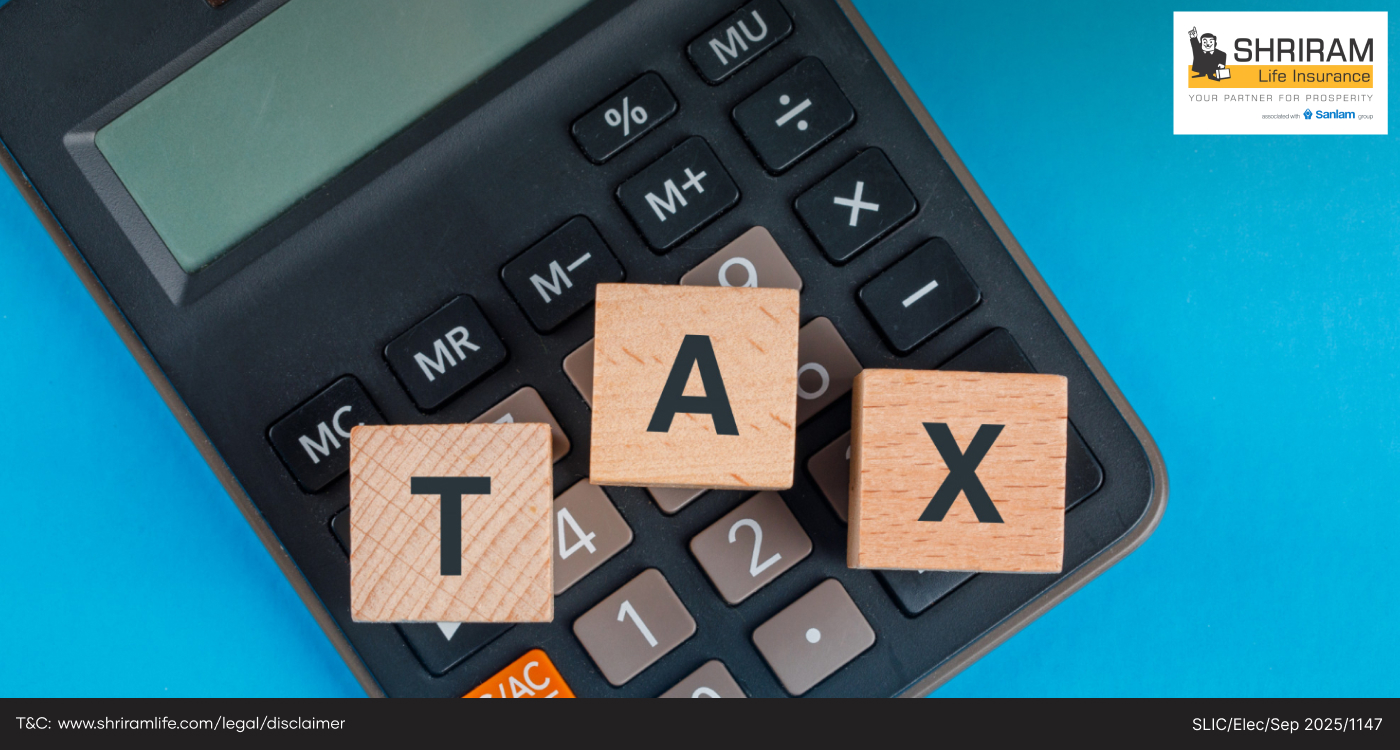Your Easy Guide to Value Added Tax Learn What VAT Means and How It Works
- Posted On: 24 Sep 2025
- Updated On: 24 Sep 2025
- 2 Views
- 5 min read

Table of Contents
- What is Value Added Tax (VAT)?
- How does VAT work?
- VAT in India After GST (What Actually Applies Today)
- VAT vs GST: What’s the Difference?
- VAT vs Sales Tax
- Advantages and Disadvantages of VAT
- How Does VAT Benefit Government, Trade, and Consumers?
- Procedure for VAT Online Registration
- Understanding VAT for Better Decisions
When you buy a product, you usually pay more than its cost price because tax gets added. One of the most common taxes around the world is VAT. If you have ever wondered what VAT is or how it impacts your bill, this will make it clear.
At Shriram Life, we help you understand taxes in simple words. You will learn what Value Added Tax means, how it works, and why it matters.
What is Value Added Tax (VAT)?
VAT, also known as Value Added Tax, is charged on the value that is added at each step, and so this type of tax is called an indirect tax. This tax gets added right from the manufacturing stage and continues till you purchase that item. In simple terms, VAT is the extra cost you pay when you buy something, and this money goes to the government.
So, this Value-Added Tax gets added to the original price of the goods and services. For example, if you buy a packet of biscuits that costs you ₹100 and VAT is 10%, you have to pay ₹110. This is how the businesses collect the tax in this form and pass it to the government.
How does VAT work?
Now, as you have a better understanding of what Value Added Tax is, it becomes easy for you to learn how VAT works.
This VAT has two parts: Input VAT and Output VAT. Both of these parts of tax are used by businesses to calculate how much they have to pay to the government.
Input VAT
Input VAT is the tax a business pays on the goods or services it buys. For example, if a baker buys flour for ₹1,000 and pays 5% VAT, the baker spends ₹1,050. The extra ₹50 is input VAT.
Businesses keep a record of all input VAT they pay. This amount can later be adjusted against the tax they collect from customers.
Output VAT
Output VAT is the tax a business collects when it sells its own goods and services. Using the baker's examples, if the baker sells bread worth ₹2,000 with 5% VAT, the customer pays ₹2,100. The extra ₹100 is output VAT.
At the end of the tax period, the baker will subtract input VAT from output VAT. This process is called set-off. If the output VAT is higher, the difference goes to the government. If input VAT is higher, the business can claim a refund.
This system ensures tax is paid only on the value added at each step and prevents double taxation.
VAT in India After GST (What Actually Applies Today)
Since July 2017, India has switched to the Goods and Services Tax (GST) system, which brought together many different indirect taxes under one single tax. Earlier, central excise, service tax, and most types of VAT were charged separately, which made compliance more complex for businesses. GST simplified this by creating a uniform tax structure across the country. While VAT is mostly replaced, the core idea of value addition remains the same.
The way GST works is very close to how does VAT work. Businesses still pay tax on their purchases, known as input tax, and collect tax on their sales, called output tax. They then claim credit for the input tax paid, so they pay tax only on the value they add to the product or service. This process keeps the system fair and avoids double taxation at different stages of production and sale.
Where You Still Pay VAT in India
Even after GST, some products are still taxed under the VAT system. These include petrol, diesel, alcohol for human consumption, and a few state-specific items. Each state decides its own VAT rate for these products.
So if you see VAT on a fuel bill, it is because GST does not cover petroleum products yet.
VAT vs GST: What’s the Difference?
Both VAT and GST are indirect taxes, but GST is a more unified system. VAT was applied by states, which meant each state had its own rules and rates. This often caused price differences between states.
GST has replaced VAT for most goods and services and brought uniform tax rates across India. It has made tax compliance easier for businesses and reduced confusion for buyers.
VAT vs Sales Tax
Sales tax is charged only at the point of final sale to the consumer. Value Added Tax, on the other hand, is charged at every stage where value is added to a product.
For example, under sales tax, only the shopkeeper charges tax when selling to you. Under VAT, the manufacturer, wholesaler, and retailer each add tax on the value they add, but they can adjust their input and output tax so that the final burden is only on the consumer.
Advantages and Disadvantages of VAT
Before looking at how VAT works in detail, it helps to see both sides of the tax. Here is a simple table of its advantages and disadvantages:
| Advantages | Disadvantages |
| Prevents tax-on-tax as the input tax credit allows set-off. This keeps the final price fair for buyers. | Compliance can feel complex for small businesses. They must keep invoices, track credits, and file returns on time. |
| Encourages businesses to keep proper records. Tracking purchases and sales builds transparency and better accounting habits. | Needs regular filing of returns. Missing deadlines may lead to fines or penalties. |
| Widens government revenue without raising direct taxes. Every purchase contributes to tax collection. | Raises prices for end consumers as tax is built into the cost. Buyers end up paying more than the base price. |
How Does VAT Benefit Government, Trade, and Consumers?
For the government, VAT gives a steady source of revenue. Each step of the supply chain contributes, so tax evasion becomes harder.
For businesses, the system rewards proper bookkeeping since input tax can be claimed back. This improves transparency in trade.
For consumers, Value Added Tax is more fair because you pay tax only on the final value, not on multiple layers of tax.
Procedure for VAT Online Registration
If your business sells items that still attract VAT, registration is mandatory. The process usually involves these steps:
- Visit the official state VAT website
- Fill out the online VAT registration form with your business details
- Upload required documents like PAN, address proof, and bank details
- Pay the registration fee online
- Wait for verification by the tax department
- Once approved, you get a VAT registration number
Learn how life insurance can lower your tax bill while protecting your family’s financial future. |
Understanding VAT for Better Decisions
Even though GST has replaced most of VAT in India, the idea of taxing only the value added at each stage is still at the heart of the system. Knowing what is VAT and how does VAT work helps you understand why prices include tax and how businesses manage their costs. This knowledge also makes you a more aware consumer.
We at Shri Ram Life are here to break down such complex topics into simple language, so you feel confident about your financial decisions and future planning.
Disclaimer: The information provided is intended for general informational purposes only. For personalised recommendations, please consult a certified insurance professional.
ARN:SLIC/Elec/Sep 2025/1148
FAQ
Is VAT still applicable in India?
Yes, VAT is still charged on a few products even after GST. Value Added Tax applies mainly on petrol, diesel, and alcohol because these items are outside GST.
Why is fuel not under GST yet?
Fuel stays under VAT as states earn a big share of revenue from it. Moving petrol and diesel to GST would reduce state earnings, so they keep it under Value Added Tax.
Is VAT charged on online shopping from abroad?
Yes, many countries charge VAT on imported goods bought online. When you order from abroad, this Value Added Tax.is often included in the price or collected at delivery.
How is VAT different from GST on insurance?
VAT applies on goods while GST applies on services like insurance. Under GST, you pay tax on your insurance premium. Value Added Tax does not apply to insurance policies.
Sum Assured vs Sum Insured: The Key to Smart Insurance Decisions
OTP Verification
Please Enter OTP that has been sent to your registered
Mobile Number +91
You may be interested in
People also search for
Our Other Popular Plans








